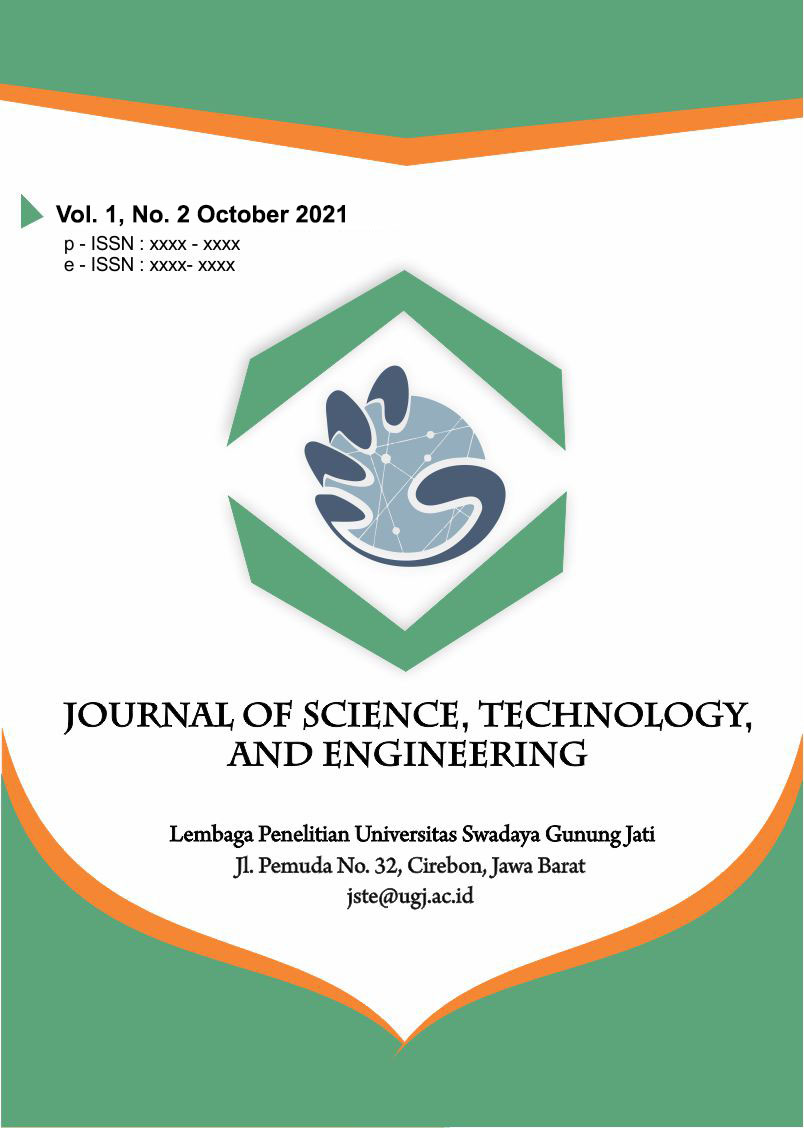Test The Effectiveness of Kesum Leaf N-Hexana Extract Gel (Polygonum Minus Huds) as A Repellant Against Mosquitoes
DOI:
https://doi.org/10.33603/jste.v1i2.6206Keywords:
kesum leaf, repellent, gel, effectivityAbstract
References
Baharum, SN, Hamidun Bunawan, Ma'aruf Abdul Ghani, Wan Aida Wan Mustapha and Normah Mohamad Noor, 2010, Analysis of the Chemical Composition of the Essential Oil of Polygonum minus Huds. Using Two-Dimensional Gas Chromatography-Time-of-Flight Mass Spectrometry (GC-TOF MS), JurnalMolecules, 15 : 7007.
Indonesian Ministry of Health, 1986, Galenik Preparation, Ministry of Health RI : Jakarta, page 28.
Ministry of Health RI, 1979. Indonesian Pharmacopoeia Edition III, Ministry of Health RI : Jakarta, page 271 ; 612.
Ministry of Health RI, 1995, Indonesian Pharmacopoeia Edition IV, Ministry of Health RI: Jakarta, page 7; 596.
Ministry of Health RI, 2000, General Standard Parameters of Medicinal Plant Extracts, Ministry of Health RI Directorate General of Drug and Food Control Directorate of Traditional Medicine Control : Jakarta, Pages 3-12.
Fradin, MS, 1998, Mosquitoes and Mosquito Repellents: A Clinician's Guide, Journal of Annals of Internal Medicine, Volume 128 , Number 11 : 932-936
Gunawan, CN, Susy Tjahjani and Sylvia Soeng, 2009, Comparison of Extracts of Lemongrass Stem (Cymbopogon citrates) and Citronella Oil as Repellents for Adult Female Culex sp Mosquitoes. Journal of Public Health, Vol.8, No.2: 152.
Harborne, JB. 1987, Phytochemical Methods, ITB Publisher: Bandung
Lachman, Leon, Herbert A. Lieberman, Joseph L. Kanig, 1994, Theory and Practice of Industrial Pharmacy II, Third Edition, University of Indonesia Publisher: Jakarta, page 1091.
Lenny, S., 2006. Terpenoid Compounds and Steroids. Scientific Works of the Faculty of Mathematics and Natural Sciences USU Medan.
Maarof, ND, Zainon Mohamad Ali, Normah Mohamad Nor and Maizon Hassan, 2010, Isolation of NADP+ Geraniol Dehydrogenase from Polygonum minus, Journal.
Mustanir and Rosnani, 2008, Isolation of Mosquito Repellent Bioactive Compounds from Acetone Extract of Legundi Plant Stems, Jurnal Bul. Littro Vol. XIX No. 2 : 177.
Othman, Saberi, Kartini Ahmad, Ramli Ibrahim and Mohamad Azlan Nafiah, 2009, Screening of Plant Species Suitable for Insect Repellent and Attractant, Journal of Science and Mathematics Vol.1, No.2 : 103 .
Rowe, RC, 2006, Handbook of Pharmaceutical Excipients, Fifth Edition, Pharmaceutical Press and America Pharmacist Association: Washington DC, Pages 111-112; 301-302 ; 794.
Sari, Retno and Dewi Isadiartuti, 2006, Study on the Effectiveness of Hand Antiseptic Gel Preparations Betel Leaf Extract (Piper betle Linn.), Indonesian Pharmacy Magazine, Vol. 17, No.4 : 165.
Sulaiman, TNS and Rina Kuswahyuning, 2008, Technology & Formulation of Semisolid Preparations, Laboratory of Pharmaceutical Technology, Gadjah Mada University : Yogyakarta, Pages 1-2 ; 4-6 ; 65-66 ; 110-111.
Syamsuni, HA, 2006, Prescription Science, EGC Medical Book Publisher: Jakarta, page 77.
Tjahjani, Susi, 2008, Repellent Power of Some Essential Oils and DEET Against Culex, Journal of Public Health, Vol.7, No.2: 182.
Voight, R., 1994, Pharmaceutical Technology Textbook, Gajah Mada University Press: Yogyakarta, Pages 340-341.
Yuliani, Sri Hartati, 2005, Repellant Gel Formulation of Fragrant Root Plants Essential Oil (Vetivera zizanioidesi (L) Nogh) : Optimization of Carbopol Composition 3%.b/v.– Propilenglikol, Indonesian Pharmacy Magazine, Vol.16, No.4 : 198 .
Yuliani, Sri Hartati, 2010, Optimization of the Combination of Sorbitol, Glycerol, and Propylene glycol in a Mango Curcuma Ethanol Extract Sunscreen Gel, Indonesian Pharmacy Magazine, Vol.21, No.2: 85.
Downloads
Published
Issue
Section
Citation Check
License
Authors who publish with this journal agree to the following terms:
- Authors retain copyright and grant the journal right of first publication with the work simultaneously licensed under a Creative Commons Attribution License that allows others to share the work with an acknowledgement of the work's authorship and initial publication in this journal.
- Authors are able to enter into separate, additional contractual arrangements for the non-exclusive distribution of the journal's published version of the work (e.g., post it to an institutional repository or publish it in a book), with an acknowledgement of its initial publication in this journal.
- Authors are permitted and encouraged to post their work online (e.g., in institutional repositories or on their website) prior to and during the submission process, as it can lead to productive exchanges, as well as earlier and greater citation of published work.
JSTE (Journal of Science, Technology, and Engineering) is licensed under a Creative Commons Attribution-NonCommercial 4.0 International License.










